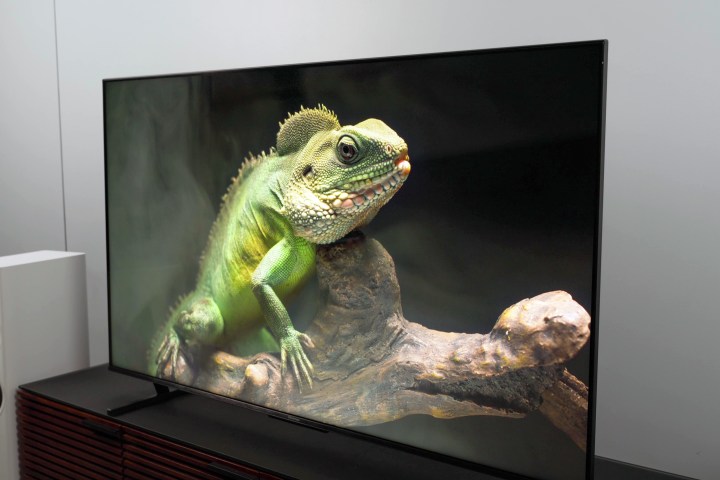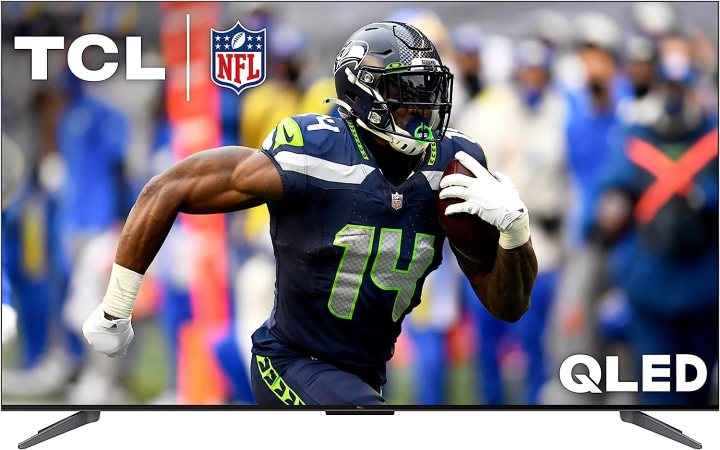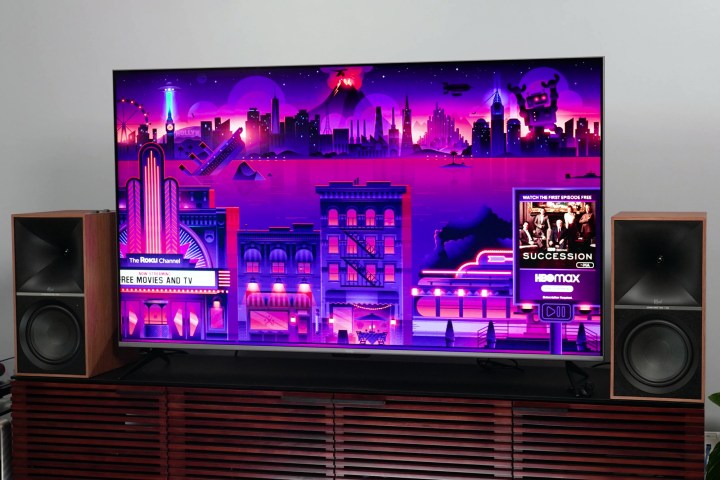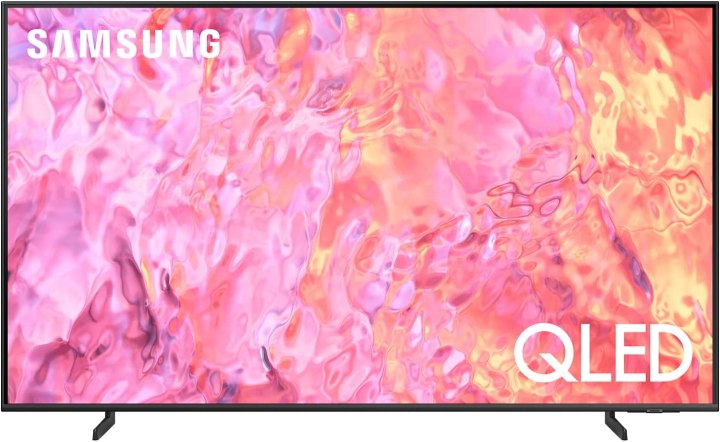Digital Trends
Next to laptops and phones, one of the most expensive consumer tech purchases most of us will face at some point is a new TV. And whether you’re deciding between an OLED or QLED, looking for a new living room set, secondary bedroom display, or a 65-inch screen for your basement gym, there’s no getting around the fact that TVs can be pretty expensive. That’s not an overarching rule though — there are also a lot of TVs on the market that cost less than $1,000.
There really isn’t a cap on size either. For example, our following roundup includes a couple of 65-inch models that come in under (or right at) $1,000. What you’ll end up spending your money on is the type of display technology the TV uses, combined with the manufacturer’s own picture-processing systems, smart TV features, and other unique capabilities.
Let’s not beat around the bush: It can still be difficult to choose a TV for less than a $1,000, because there are a lot of sets that fit the literal bill. Luckily, that’s where we come in! We test all the latest and greatest TVs every year, putting them through our rigorous TV review process to check all the important elements such as brightness, color accuracy, contrast, sound, and much more. Here, then, is our list of all the best TVs under $1,000.

Zeke Jones / Digital Trends
Hisense 65-inch U8N ULED
Our favorite TV for under $1,000
Pros
- Intense brightness
- Deep blacks/contrast
- Vibrant, accurate color
- Great sound
Cons
- Overly bright HDR
- Poor off-angle viewing
It brings us great joy to be able to call Hisense’s 2024 flagship our best overall pick for a TV that costs less than a grand. We had the opportunity to take the U8N Series for a spin not too long ago, and we were totally blown away by the new heights Hisense has summited. Our editor-at-large, Caleb Denison, was taken aback by the exceptional brightness levels the U8N was able to achieve in our hands-on review, to the point that he felt it wise to proclaim that the illumination is actually a little too intense when viewing HDR content.
Thanks to its improved chipset, the U8N Series is able to deliver better overall brightness on top of vibrant colors and impressive contrast levels that rival the performance of some the best OLED TVs. And thanks to its top-notch reflection handling, the U8N can hang out in just about any brightly lit room. There’s a bit of trouble with the TV’s off-angle viewing, which is an unfortunate malady of some LED LCDs. That being said, it’s best to watch this set as centered with the screen as possible.
The U8N supports leading HDR formats like Dolby Vision, and thanks to HDMI 2.1 connectivity, game consoles and PCs run at lightning-fast speed when hooked up to Hisense’s flagship. Expect minimal input lag, quick response times, and 4K/144Hz for max resolution/refresh rate performance. The U8N also uses the Google TV OS for smart TV content and other UI elements and has a 50W 2.1.2 speaker configuration that sounds a lot better than most TV speakers.

Hisense 65-inch U8N ULED
Our favorite TV for under $1,000

Image used with permission by copyright holder
Hisense 65-inch U8K ULED
The runner-up
Pros
- Excellent brightness
- Vivid HDR colors
- Very good backlight control
- Excellent contrast
- Great for gaming
Cons
- Some color anomalies
- Scattered software bugs
The Hisense U8K Series was our favorite TV for less than $1,000 in 2023, and this fantastic model still deserves a high rung on this ladder. You may be wondering what the differences are between Hisense’s 2024 and 2023 flagships. To be honest, the U8N Series is a little better than the U8K in just about every way, including overall brightness levels, color accuracy, contrast, motion performance, and input lag. That being said, the 65-inch version of the U8K is currently the same price as the 65-inch U8N, but the latter is on sale, and the former is not. And we know for a fact that the 65-inch U8K has been priced as low as $900, so once a new sale comes around, this model should be even cheaper.
We were completely blown away by a number of the U8K’s impressive features, but a true standout was its peak brightness capabilities. For those nit nerds who have a vested interest in those kinds of specs, we captured max brightness output at 2,000 nits (although it promises only 1,500), which is pretty darn good in our book! The U8K also scores big in the color accuracy and motion clarity departments (with the former being slightly better than the latter).
HDR connoisseurs will also be pleased to know that the U8K supports HDR10, HDR10+, and Dolby Vision. And as far as streaming content goes, we can never stop singing the praises of Google TV, which just so happens to be Hisense’s operating system of choice. Stream movies and TV shows from services like Netflix, Hulu, Amazon Prime Video, Disney+, and Max, while Google builds personalized recommendations for you based on your viewing history.
In terms of sound quality, the U8K isn’t too shabby either. In fact, Hisense is really the last of a dying breed when it comes to TV companies that care about giving you decent speakers. No, it’s not a surround-sound replacement, but if you’re stuck without Dolby Atmos or even a soundbar, the U8K’s onboard audio will do just fine.


Amazon / TCL
TCL 65-inch Q7 QLED
Another awesome TCL
Pros
- High brightness
- Great contrast
- Vivid color
- Great for gaming
Cons
- White balance is just bad
- Color is technically inaccurate
- Inconsistent picture quality from streaming apps
The TCL name has come a long way to become one of the best TV brands on the market, and anyone looking for a powerful QLED TV for less than a grand will be interested in this TV.
Its arresting brightness performance has been improved thanks to its High Brightness Pro LED backlight at up to 1,000 nits peak. The Q7’s backlight also has more than 200 full-array local dimming zones that dynamically adapt to on-screen content. Boasting quantum dot-boosted colors, advanced HDR support (Dolby Vision IQ, HDR10+, HDR10, and HLG), and gamer-optimized 240Hz VRR (the Q7 has a native 120Hz refresh rate), the Q7 QLED performs like it costs way more than a grand.
Google TV runs the show for all things smart and smart-adjacent (like Google Chromecast). Similar to Hisense’s duel of the U8K and U7K models, the only differentiator between TCL’s Q7 and QM8 is the amount of local dimming zones and peak brightness levels. If you’ve got the extra dough to spare, you may want to opt for the company flagship, but the Q7 is still an incredible pick.

TCL 65-inch Q7 QLED
Another awesome TCL

Zeke Jones/Digital Trends
Roku 65-inch Plus Series QLED
Best for Roku OS enthusiasts
Pros
- High brightness
- Brilliant color
- Snappy operation
- Impressive sound
- Great remote
Cons
- Poor off-angle performance
- Contrast suffers in high-brightness scenes
- Some motion blur
Roku’s TV OS is one of the go-to platforms for entertainment apps like Netflix, Disney+, and Amazon Prime Video, and the company has been making exceptional streaming devices for almost two decades. Thus, it was only a matter of time before Roku decided to make its own TVs, and they’re sold exclusively through Best Buy.
Enter the Roku 65-inch Plus Series QLED. As far as pros go, the Plus Series QLED delivers exceptional brightness and accurate colors, as well as some top-notch sound for the price. This latter feat is becoming increasingly difficult to satisfy without a soundbar, so the fact that Roku achieved a full and rich soundstage using just TV speakers is a big deal.
What we’re not a fan of here is the 60Hz refresh rate. That’s the motion clarity cap on this model, and while stutter and blur are less evident on smaller screens, a 65-inch panel is going to have more trouble hiding these maladies. This is going to be a deal-breaker for some, and we totally get it, but for those who don’t mind a little blur once in awhile, the Plus Series is still an exceptional choice for a large LED.
It’s also got four HDMI inputs, AirPlay 2 compatibility, and full-array backlighting, which means there are LEDs behind every square-inch of the screen, instead of just the edges.

Roku 65-inch Plus Series QLED
Best for Roku OS enthusiasts

Image used with permission by copyright holder
Amazon 65-inch Fire TV Omni QLED
Affordable, with Amazon Fire TV baked in
Pros
- Excellent Fire TV experience
- Great smart home hub
- Adequate picture performance
- Fun features
Cons
- Lacks HDR punch
- Price-to-picture performance ratio is off
Amazon’s first-party TVs are pretty good when it comes to overall picture quality, but even better when it comes to saving you cash, and that’s where the Fire TV Omni QLED comes in.
Amazon has been making TVs for a few years now, and while they’re not the kinds of sets we’d point all our friends toward, these Alexa-powered displays are great when funds are limited. But you know what? The 65-inch Omni QLED is actually pretty awesome all-around, and it costs far less than the average 65-inch LED at around $800.
Perhaps the biggest win to write home about is that the Omni QLED supports each and every HDR format out there (Dolby Vision IQ, HDR10+ Adaptive, HDR10, and HLG). So whether you’re streaming your favorite movies from Netflix or popping in your 4K Blu-ray copy of Jurassic World: Dominion, the Omni QLED is equipped to push the kind of breathtaking brightness, colors, and contrast that one should expect from an HDR viewing. This Amazon Omni TV also has Amazon’s Adaptive Brightness feature that, if utilized, actively measures the lighting in your room and optimizes the TVs brightness. It also features the Fire TV Ambient Experience that turns the TV into an art display when idle — it can feature your photos, Alexa widgets, and more than 1,000 works of art.
Omni also has Alexa built in, allowing you to control all the smart home devices in your house. Yes, the Omni QLED has a little bit of trouble with light blooming, and the refresh rate only tops out at 60Hz, but it’s going to be pretty difficult to score this insane of a deal for a screen as big, bright, and colorful as this one.

Amazon 65-inch Fire TV Omni QLED
Affordable, with Amazon Fire TV baked in

Amazon / Samsung
Samsung 70-inch Q60C QLED
A big screen for less than $1,000
Pros
- Great price for the size
- Solid 4K upscaling
- Decent HDR performance
Cons
- Only 60Hz refresh rate
- Some issues with light blooming
- Not as advanced as other models on this list
It’s not an overperformer in the picture quality department, but for the size and the price, the Samsung 70-inch Q60C QLED delivers a solid big TV experience, especially for fans of the Samsung name that want as big of a TV as they can get.
Sometimes the most important part of a new flat-screen purchase is making sure the screen is as big as possible. Unfortunately, most 65-inch-plus TVs cost a pretty penny, but we were determined to find a make and model that came in below cost, while still delivering an awesome picture, and so we’ve landed on the Samsung 70-inch Q60C QLED. To be honest, we didn’t think we’d be able to include a Samsung in this roundup at all. We all know it makes amazing TVs, but for something on the bigger side, they’re usually way more than $1,000. The Q60C really fits the bill though.
As far as picture tech goes, the Quantum Processor Lite handles all 4K optimization, ensuring that even SDR sources look crisp and colorful. There’s also some pretty decent HDR support (HDR10+ and HLG) and motion acceleration built in for good measure. The latter is much needed though, because a big part of your savings on the Q60C comes from the set’s native 60Hz refresh rate. Yeah, it’s not exactly ideal for a larger screen, and we don’t recommend this TV for gamers, but there’s plenty to love about this Samsung (including awesome smart TV features and Object Tracking Sound Lite), even though it doesn’t have a 120Hz panel.

Samsung 70-inch Q60C QLED
A big screen for less than $1,000

Sony
Sony 65-inch X80K LED
Sony name and image processing for less than a grand
Pros
- Bright and colorful picture
- Solid 4K upscaling
- Great gaming optimizations
Cons
- Only 60Hz refresh rate
- Not the best HDR performance
Sony is one of the top brands in the world of TVs, but there’s usually quite a premium to pay if you want to own a Bravia mini LED or QD-OLED. That’s why we’re glad to draw attention to the Sony 65-inch X80K.
Going back to basics, the X80K is a traditional LED-LCD built on the Google TV UI. While we’re not dealing with a fully backlit screen, the X80K can get plenty bright, and has a wide viewing angle. With the Cognitive Processor X1 and Triluminos Pro handling upscaling, colors, and contrast, the X80K is terrific at making older content look revamped.
The TV does have a couple of flaws though. Because there’s no local dimming to speak of, HDR dark scenes tend to look gray instead of black. The screen also isn’t great for standing up against harsh sunlight, and there’s no VRR support either.
These few qualms aside though, the Sony 65-inch X80K delivers a solid picture for the price, and gets you a model from one of the most reliable brands in the business.

Sony 65-inch X80K LED
Sony name and image processing for less than a grand
Frequently Asked Questions
What size TV can I afford for $1,000?
You’ll be able to find a TV as large as 75 inches for under $1,000.
Can I get an OLED TV for less than $1,000?
Yes, but very rarely with deals. OLED TV technology still is primarily available on high-end models that soar beyond the $1,000 mark. But we’re starting to see some models dip below a grand.
Do TVs under $1,000 work with Alexa, Google Assistant, or Siri?
Using either Google Home, Fire TV, or an Amazon Echo, you can pair many modern TVs with Google Assistant and Amazon Alexa. Many newer TVs have these options built-in, so you can use them without buying a separate appliance. Unfortunately, no current models of TVs have Siri built-in, so you’ll have to try a workaround. For example, TVs that support AirPlay 2 and HomeKit let you control them by using Siri on an iOS device, such as an iPad, iPhone, iPod, and Mac.
What outputs should TVs under $1,000 have?
The No. 1 thing to consider is HDMI in terms of outputs and inputs. We recommend purchasing a TV with HDMI ARC or eARC, which means your TV audio can stream to an AV receiver or a soundbar. Every TV we’ve included on this list has at least one HDMI ARC port, and most have three total HDMI ports. This means you’ll have plenty of image and audio channels available to connect gaming consoles, Blu-ray players, and set-top streaming devices to your system. Getting the latest generation of HDMI is also important for enabling the most recent visual/audio options.
What is the best month to buy a TV?
There are several times in the year that are good for buying a TV. Let’s get the obvious out of the way — Black Friday and the surrounding holidays tend to have the best deals for things like TVs, so November and December are clear choices. But if you missed a deal or it ran out of stock, these can also be annoying months to buy. We suggest also looking for deals in January when brands discount in preparation for the Super Bowl, and in April and May, when many TVs go on sale.
Which TV brands last the longest?
With proper care, TVs can last for many years. But Samsung and LG have particularly good reputations for durable TVs that can handle long-term use without developing annoying issues like damaged pixels, while still offering top-notch quality. Check out our excellent post on the best TV brands for more details.

